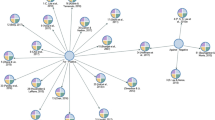Abstract
Social choice theory suggests that the occurrence of cyclical collective preferences should be a widespread phenomenon, especially in large groups of decision-makers. However, empirical research has so far failed to produce evidence of the existence of many real-world examples of such, and none in large electorates. This paper demonstrates the existence of a real cyclical majority in a poll of Danish voters' preferred prime minister, using pair-wise comparisons. This result is compared with those of a similar poll, but by using different voting methods, each resulting in different choices. The example demonstrates the empirical reality of cyclical collective preferences and the importance of the choice of institutions.
Similar content being viewed by others
References
Arrow, K.J. (1951). Social choice and individual values, 2nd rev. edn. New Haven: Yale University Press, 1963.
Black, D. (1958). The theory of committees and elections, 2nd rev. edn. Dordrecht: Kluwer, 1998.
Blydenburgh, J.C. (1971). The closed rule and the paradox of voting. Journal of Politics 33: 57-71.
Borre, O., and Andersen, J.G. (1997). Voting and political attitudes in Denmark: A study of the 1994 election. Aarhus: Aarhus University Press.
Campbell, C. and Tullock, G. (1965). A measure of the importance of cyclical majorities. Economic Journal 75: 853-857.
Chamberlain, J.R., Cohen, J.L. and Coombs, C.H. (1984). Social choice observed: Five presidential elections of the American Psychological Association. Journal of Politics 46: 479-502.
DeMeyer, F. and Plott, C.R. (1970). The probability of a cyclical majority. Econometrica 38: 345-354.
Dobra, J.L. (1983). An approach to empirical studies of voting paradoxes: An update and extension. Public Choice 41: 241-250.
Downs, A. (1957). An economic theory of democracy. New York: Harper and Row.
Feld, S.L. and Grofman, B. (1992): Who's afraid of the Big Bad Cycle? Evidence from 36 elections. Journal of Theoretical Politics 4: 231-237.
Garman, M.B. and Kamien, M.I. (1968). The paradox of voting: Probability calculations. Behavioral Science 13: 306-316.
Gehrlein, W.V. (1983). Condorcet's paradox. Theory and Decision 15: 161-197.
Gehrlein, W.V. and Fishburn, P.C. (1976). The probability of the paradox of voting: A computable solution. Journal of Economic Theory 13: 14-25.
Jamison, D.T. (1975). The probability of intransitive majority rule: An empirical study. Public Choice 23: 87-94.
Jones, B., Radcliff, B., Taber, C. and Timpone, R. (1995). Condorcet winners and the paradox of voting: Probability calculations for weak preference orders. American Political Science Review 89: 137-147.
Klahr, D. (1966). A computer simulation of the paradox of voting. American Political Science Review 60: 384-390.
Kurrild-Klitgaard, P. (1996). Magt, demokrati og kollektive valgs rationalitet, AP 1996/4. København: Institut for Statskundskab. In U. Jakobsen and M. Kelstrup (Eds.), Demokrati: Teorier og Begreber. Copenhagen: Political Studies Press, forthcoming 1999.
Lagerspaetz, E. (1993). Social choice in the real world. Scandinavian Political Studies 16: 1-23.
Lagerspaetz, E. (1997). Social choice in the real world II: Cyclical preferences and strategic voting in the Finnish presidential elections. Scandinavian Political Studies 20: 53-67.
Lewin, L. (1996). Votera eller Förhandla? Om Den Svenska Parlamentarismen. Stockholm: Fritzes.
Lewin, L. (1998). Majoritarian and consensus democracy: The Swedish experience. Scandinavian Political Studies 21: 195-206.
Niemi, R.G. (1970). The occurrence of the paradox of voting in university elections. Public Choice 8: 91-100.
Niemi, R.G. and Weisberg, H.F. (1968). A mathematical solution for the probability of the paradox of voting. Behavioral Science 13: 317-323
Niemi, R.G. and Wright, S. (1987). Voting cycles and the structure of individual preferences. Social Choice and Welfare 4: 173-183.
Plott, C.R. (1976). Axiomatic social choice theory: An overview and interpretation. American Journal of Political Science 20: 511-596.
Radcliff, B. (1994). Collective preferences in presidential elections. Electoral Studies 13: 50-57.
Riker, W.H. (1958). The paradox of voting and congressional rules for voting on amendments. American Political Science Review 52: 349-366.
Riker, W.H. (1965). Arrow's Theorem and some examples of the paradox of voting. In J.M. Claunch (Ed.), Mathematical applications in political science, Vol. I. Dallas: Southern Methodist University Press: 41-60.
Riker, W.H. (1982). Liberalism against populism: A confrontation between the theory of democracy and the theory of social choice. Prospect Heights: Waveland Press.
Riker, W.H. (1986). The art of manipulation. New Haven: Yale University Press.
Shepsle, K.A. (1979). Institutional arrangements and equilibrium in multidimensional voting models. American Journal of Political Science 23: 27-59.
Shepsle, K.A. and Weingast, B.R. (1981). Structure-induced equilibrium and legislative choice. Public Choice 37: 503-519.
Tullock, G. (1967). Toward a mathematics of politics. Ann Arbor: University of Michigan Press.
Tullock, G. (1981). Why so much stability? Public Choice 37: 189-202.
Van Deemen., A.M.A. (1998a). The probability of the paradox of voting for weak preference orderings. Social Choice and Welfare forthcoming.
Van Deemen, A.M.A. (1998b). The Condorcet paradox: A review of research results. Paper presented at the Workshop on Empirical Social Choice, ECPR Joint Sessions, Warwick, March 23-28, 1998.
Van Deemen, A.M.A. and Vergunst, N.P. (1998). Empirical evidence of paradoxes of voting in Dutch elections. Public Choice 97: 475-490.
Van den Doel, H. (1979). Democracy and welfare economics. Cambridge: Cambridge University Press.
Vergunst, N.P. (1996). Besluitvorming over kerncentrale Borssele: Een analyse van de stemparadox in de Nederlandse politiek. Acta Politica 31: 209-228.
Author information
Authors and Affiliations
Rights and permissions
About this article
Cite this article
Kurrild-Klitgaard, P. An Empirical Example of the Condorcet Paradox of Voting in a Large Electorate. Public Choice 107, 135–145 (2001). https://doi.org/10.1023/A:1010304729545
Issue Date:
DOI: https://doi.org/10.1023/A:1010304729545




